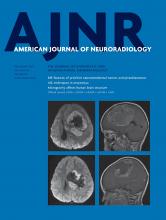Abstract
BACKGROUND AND PURPOSE: Iterative reconstruction has promise in lowering the radiation dose without compromising image quality, but its full potential has not yet been realized. While phantom studies cannot fully approximate the subjective effects on image quality, live animal models afford this assessment. We characterize dose reduction in head CT by applying advanced modeled iterative reconstruction (ADMIRE) in a live ovine model while evaluating preservation of gray-white matter detectability and image texture compared with filtered back-projection.
MATERIALS AND METHODS: A live sheep was scanned on a Force CT scanner (Siemens) at 12 dose levels (82–982 effective mAs). Images were reconstructed with filtered back-projection and ADMIRE (strengths, 1–5). A total of 72 combinations (12 doses × 6 reconstructions) were evaluated qualitatively for resemblance to the reference image (highest dose with filtered back-projection) using 2 metrics: detectability of gray-white matter differentiation and noise-versus-smoothness in image texture. Quantitative analysis for noise, SNR, and contrast-to-noise was also performed across all dose-strength combinations.
RESULTS: Both qualitative and quantitative results confirm that gray-white matter differentiation suffers at a lower dose but recovers when complemented by higher iterative reconstruction strength, and image texture acquires excessive smoothness with a higher iterative reconstruction strength but recovers when complemented by dose reduction. Image quality equivalent to the reference image is achieved by a 58% dose reduction with ADMIRE-5.
CONCLUSIONS: An approximately 60% dose reduction may be possible while preserving diagnostic quality with the appropriate dose-strength combination. This in vivo study can serve as a useful guide for translating the full implementation of iterative reconstruction in clinical practice.
ABBREVIATIONS:
- ADMIRE
- advanced modeled iterative reconstruction
- CNR
- contrast-to-noise ratio
- FBP
- filtered back-projection
- IR
- iterative reconstruction
- © 2019 by American Journal of Neuroradiology












